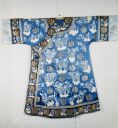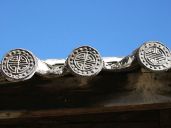Is It 壽?
At first glance the medallions between the narcissi look odd yet harmonious at the same time. However, if you look closer there are two things that you can recognize: the swastikas and the seal script-like writing. The swastika 卍, not to be confused with the nazi version, is a religious symbol that was also used before Buddhism. In China, this symbol became the representation of Buddhism and the Buddha himself. Thus, it was seen as an auspicious sign. The meaning of the symbol also changed once Empress Wu Zetian (r.685-705) named the swastika wan (萬) which literally means ten thousand or boundless. From then on the swastika has been used with other motifs or symbols to combine their meaning.[Cf, p 1004, 1085] In this case, the swastika has indeed been used as an added compound. The medallion without the swastikas means Shou 壽 (longevity). Combined with the two swastikas it would mean 萬萬壽 which translates to “May you live for ten thousand years”[Cf, p 1088] I do have to note that in the “Ladder to the Clouds” the same symbol was drawn in which the caption said Ji (Luck).[Cf, p 212] With these kinds of symbols it is hard to determine the true meaning, firstly since we don’t know whether Katherine painted all the symbols accurately, and secondly there is no illustrated catalog with these symbols. I personally do think that it is supposed to be 萬萬壽 as there are many other symbols that suggest longevity. Take a look at the Manchurian cranes and more variants of 壽 at the end of the sleeves and dress.



